Effect of Fe on Calcined Ni(OH)2 Anode in Alkaline Water Electrolysis
Abstract
1. Introduction
2. Results
2.1. Monometallic Ni Electrodes
2.1.1. Phase Change of Ni(OH)2 According to Calcination Temperature
2.1.2. OER Characteristics According to Calcination Temperature
2.2. Activation of NiO Electrode
2.2.1. Influence of OER on Structural Change of Ni(5)-400 °C Electrode
2.2.2. Influence of Iron Impurities on Nickel Oxide-Electrode
2.3. Reaction Characteristics of Nickel-Iron Oxide Electrodes
2.3.1. Phase and OER Characteristics of Nickel-Iron Oxide Electrodes
2.3.2. Relationship between Coating Solution Nickel Concentration and Nickel-Iron Oxide Electrode Activity
2.3.3. Relation between Loading Solution Iron Concentration and Nickel Iron-Oxide Electrode Activity
3. Materials and Methods
3.1. Electrode Preparation
3.1.1. Pretreatment
3.1.2. Synthesis of (hydr)Oxide Electrodes
3.1.3. Heat Treatment
3.1.4. Fe Impregnation and Heat Treatment
3.2. Purification of KOH Solution
3.3. Analysis of Physicochemical Properties
3.4. Analysis of Electrochemical Properties
4. Conclusions
Supplementary Materials
Author Contributions
Funding
Data Availability Statement
Conflicts of Interest
References
- IRENA. Renewable Energy Statistics 2022; The International Renewable Energy Agency: Masdar City, United Arab Emirates, 2022. [Google Scholar]
- Yang, L.; Hu, Z.; Xie, S.; Kong, S.; Lin, W. Adjustable Virtual Inertia Control of Supercapacitors in PV-Based AC Microgrid Cluster. Electr. Power Syst. Res. 2019, 173, 71–85. [Google Scholar] [CrossRef]
- David, M.; Ocampo-martínez, C.; Sánchez-peña, R. Advances in Alkaline Water Electrolyzers: A Review. J. Energy Storage 2019, 23, 392–403. [Google Scholar] [CrossRef]
- Yue, M.; Lambert, H.; Pahon, E.; Roche, R.; Jemei, S.; Hissel, D. Hydrogen Energy Systems: A Critical Review of Technologies, Applications, Trends and Challenges. Renew. Sustain. Energy Rev. 2021, 146, 111180. [Google Scholar] [CrossRef]
- Singh, T.I.; Rajeshkhanna, G.; Pan, U.N.; Kshetri, T.; Lin, H.; Kim, N.H.; Lee, J.H. Alkaline Water Splitting Enhancement by MOF-Derived Fe–Co–Oxide/Co@NC-MNS Heterostructure: Boosting OER and HER through Defect Engineering and In Situ Oxidation. Small 2021, 17, 2101312. [Google Scholar] [CrossRef]
- Li, X.; Kou, Z.; Xi, S.; Zang, W.; Yang, T.; Zhang, L.; Wang, J. Porous NiCo2S4/FeOOH Nanowire Arrays with Rich Sulfide/Hydroxide Interfaces Enable High OER Activity. Nano Energy 2020, 78, 105230. [Google Scholar] [CrossRef]
- Trotochaud, L.; Ranney, J.K.; Williams, K.N.; Boettcher, S.W. Solution-Cast Metal Oxide Thin Film Electrocatalysts for Oxygen Evolution. J. Am. Chem. Soc. 2012, 134, 17253–17261. [Google Scholar] [CrossRef]
- Subbaraman, R.; Tripkovic, D.; Chang, K.C.; Strmcnik, D.; Paulikas, A.P.; Hirunsit, P.; Chan, M.; Greeley, J.; Stamenkovic, V.; Markovic, N.M. Trends in Activity for the Water Electrolyser Reactions on 3d M(Ni,Co,Fe,Mn) Hydr(Oxy)Oxide Catalysts. Nat. Mater. 2012, 11, 550–557. [Google Scholar] [CrossRef]
- Babar, P.T.; Lokhande, A.C.; Gang, M.G.; Pawar, B.S.; Pawar, S.M.; Kim, J.H. Thermally Oxidized Porous NiO as an Efficient Oxygen Evolution Reaction (OER) Electrocatalyst for Electrochemical Water Splitting Application. J. Ind. Eng. Chem. 2018, 60, 493–497. [Google Scholar] [CrossRef]
- Tao, S.; Wen, Q.; Jaegermann, W.; Kaiser, B. Formation of Highly Active NiO(OH) Thin Films from Electrochemically Deposited Ni(OH)2 by a Simple Thermal Treatment at a Moderate Temperature: A Combined Electrochemical and Surface Science Investigation. ACS Catal. 2022, 12, 1508–1519. [Google Scholar] [CrossRef]
- Stern, L.A.; Hu, X. Enhanced Oxygen Evolution Activity by NiOx and Ni(OH)2 Nanoparticles. Faraday Discuss. 2014, 176, 363–379. [Google Scholar] [CrossRef]
- Corrigan, D.A.; Maheswari, S.P. The Catalysis of the Oxygen Evolution Reaction by Iron Impurities in Thin Film Nickel Oxide Electrodes. Electrochem. Soc. Ext. Abstr. 1985, 134, 377–384. [Google Scholar] [CrossRef]
- Liu, X.; Zhai, Z.Y.; Chen, Z.; Zhang, L.Z.; Zhao, X.F.; Si, F.Z.; Li, J.H. Engineering Mesoporous NiO with Enriched Electrophilic Ni3+ and O− toward Efficient Oxygen Evolution. Catalysts 2018, 8, 310. [Google Scholar] [CrossRef]
- Wu, Y.J.; Yang, J.; Tu, T.X.; Li, W.Q.; Zhang, P.F.; Zhou, Y.; Li, J.F.; Li, J.T.; Sun, S.G. Evolution of Cationic Vacancy Defects: A Motif for Surface Restructuration of OER Precatalyst. Angew. Chem. Int. Ed. 2021, 60, 26829–26836. [Google Scholar] [CrossRef] [PubMed]
- Obradović, M.D.; Gojković, S.L. Challenges in Determining the Electrochemically Active Surface Area of Ni–Oxides in the Oxygen Evolution Reaction. J. Electroanal. Chem. 2022, 918, 116479. [Google Scholar] [CrossRef]
- Gund, G.S.; Dubal, D.P.; Jambure, S.B.; Shinde, S.S.; Lokhande, C.D. Temperature Influence on Morphological Progress of Ni(OH)2 Thin Films and Its Subsequent Effect on Electrochemical Supercapacitive Properties. J. Mater. Chem. A Mater. 2013, 1, 4793–4803. [Google Scholar] [CrossRef]
- Klaus, S.; Cai, Y.; Louie, M.W.; Trotochaud, L.; Bell, A.T. Effects of Fe Electrolyte Impurities on Ni(OH)2/NiOOH Structure and Oxygen Evolution Activity. J. Phys. Chem. C 2015, 119, 7243–7254. [Google Scholar] [CrossRef]
- Chen, J.Y.C.; Dang, L.; Liang, H.; Bi, W.; Gerken, J.B.; Jin, S.; Alp, E.E.; Stahl, S.S. Operando Analysis of NiFe and Fe Oxyhydroxide Electrocatalysts for Water Oxidation: Detection of Fe4+ by Mössbauer Spectroscopy. J. Am. Chem. Soc. 2015, 137, 15090–15093. [Google Scholar] [CrossRef] [PubMed]
- Sengupta, D.; Privitera, S.M.S.; Milazzo, R.G.; Bongiorno, C.; Scalese, S.; Lombardo, S. Ni Foam Electrode Solution Impregnated with Ni-FeX(OH)Y Catalysts for Efficient Oxygen Evolution Reaction in Alkaline Electrolyzers. RSC Adv. 2020, 10, 25426–25434. [Google Scholar] [CrossRef] [PubMed]
- Lee, S.H.; Kim, J.E.; Joo, H.; Park, C.S.; Jeong, S.U.; Jung, K.; Kim, Y.H.; Kang, K.S. Effect of Plating Variables on Oxygen Evolution Reaction of Ni–Zn–Fe Electrodes for Alkaline Water Electrolysis. Catalysts 2022, 12, 346. [Google Scholar] [CrossRef]
- Chen, J.; Zheng, F.; Zhang, S.J.; Fisher, A.; Zhou, Y.; Wang, Z.; Li, Y.; Xu, B.B.; Li, J.T.; Sun, S.G. Interfacial Interaction between FeOOH and Ni-Fe LDH to Modulate the Local Electronic Structure for Enhanced OER Electrocatalysis. ACS Catal. 2018, 8, 11342–11351. [Google Scholar] [CrossRef]
- Liu, C.; Han, Y.; Yao, L.; Liang, L.; He, J.; Hao, Q.; Zhang, J.; Li, Y.; Liu, H. Engineering Bimetallic NiFe-Based Hydroxides/Selenides Heterostructure Nanosheet Arrays for Highly-Efficient Oxygen Evolution Reaction. Small 2021, 17, 2007334. [Google Scholar] [CrossRef] [PubMed]
- Gong, M.; Dai, H. A Mini Review of NiFe-Based Materials as Highly Active Oxygen Evolution Reaction Electrocatalysts. Nano Res. 2015, 8, 23–39. [Google Scholar] [CrossRef]
- Lee, S.Y.; Kim, I.S.; Cho, H.S.; Kim, C.H.; Lee, Y.K. Resolving Potential-Dependent Degradation of Electrodeposited Ni(OH)2 Catalysts in Alkaline Oxygen Evolution Reaction (OER): In Situ XANES Studies. Appl. Catal. B Environ. 2021, 284, 119729. [Google Scholar] [CrossRef]
- Trotochaud, L.; Young, S.L.; Ranney, J.K.; Boettcher, S.W. Nickel-Iron Oxyhydroxide Oxygen-Evolution Electrocatalysts: The Role of Intentional and Incidental Iron Incorporation. J. Am. Chem. Soc. 2014, 136, 6744–6753. [Google Scholar] [CrossRef]
- Louie, M.W.; Bell, A.T. An Investigation of Thin-Film Ni-Fe Oxide Catalysts for the Electrochemical Evolution of Oxygen. J. Am. Chem. Soc. 2013, 135, 12329–12337. [Google Scholar] [CrossRef] [PubMed]
- Kuai, C.; Xi, C.; Hu, A.; Zhang, Y.; Xu, Z.; Nordlund, D.; Sun, C.J.; Cadigan, C.A.; Richards, R.M.; Li, L.; et al. Revealing the Dynamics and Roles of Iron Incorporation in Nickel Hydroxide Water Oxidation Catalysts. J. Am. Chem. Soc. 2021, 143, 18519–18526. [Google Scholar] [CrossRef] [PubMed]
- Friebel, D.; Louie, M.W.; Bajdich, M.; Sanwald, K.E.; Cai, Y.; Wise, A.M.; Cheng, M.J.; Sokaras, D.; Weng, T.C.; Alonso-Mori, R.; et al. Identification of Highly Active Fe Sites in (Ni,Fe)OOH for Electrocatalytic Water Splitting. J. Am. Chem. Soc. 2015, 137, 1305–1313. [Google Scholar] [CrossRef]
- Yang, L.; Liu, Z.; Zhu, S.; Feng, L.; Xing, W. Ni-Based Layered Double Hydroxide Catalysts for Oxygen Evolution Reaction. Mater. Today Phys. 2021, 16, 100292. [Google Scholar] [CrossRef]
- Dong, Y.; Yang, J.; Liu, Y.; Wang, Y.; Dong, Z.; Cui, M.; Li, M.; Yuan, X.; Zhang, X.; Dai, X. 2D Fe-Doped NiO Nanosheets with Grain Boundary Defects for the Advanced Oxygen Evolution Reaction. Dalton Trans. 2020, 49, 6355–6362. [Google Scholar] [CrossRef]
- Kim, J.E.; Bae, K.K.; Park, C.S.; Jeong, S.U.; Kim, J.W.; Yoon, J.; Cho, H.; Lee, K.B.; Kang, K.S. Nickel–Iron Hydroxide Oxygen Evolution Electrocatalysts Prepared by a Simple Chemical Bath Deposition Method. Int J Hydrog. Energy 2021, 46, 20313–20324. [Google Scholar] [CrossRef]
- Gadalla, A.M. Thermal Behavior of Oxides and Hydroxides of Iron and Nickel. Thermochim. Acta 1989, 145, 1–9. [Google Scholar] [CrossRef]
- Hoque, N.A.; Thakur, P.; Kool, A.; Das, S.; Ray, P.P. Optical and Dielectric Properties of Hydrothermally Synthesized Ni(OH)2 Nanoparticles: A Morphology and Size Dependent Study. J. Mater. Sci. Mater. Electron. 2017, 28, 5375–5383. [Google Scholar] [CrossRef]
- Jung, S.; McCrory, C.C.L.; Ferrer, I.M.; Peters, J.C.; Jaramillo, T.F. Benchmarking Nanoparticulate Metal Oxide Electrocatalysts for the Alkaline Water Oxidation Reaction. J. Mater. Chem. 2016, 4, 3068–3076. [Google Scholar] [CrossRef]
- Zhou, Y.; López, N. The Role of Fe Species on NiOOH in Oxygen Evolution Reactions. ACS Catal. 2020, 10, 6254–6261. [Google Scholar] [CrossRef]
- Golabi, S.M.; Nozad, A. Electrocatalytic Oxidation of Methanol on a Nickel-Porphyrin IX Complex Modified Glassy Carbon Electrode in Alkaline Medium. Electroanalysis 2004, 16, 199–209. [Google Scholar] [CrossRef]
- Li, Y.F.; Li, J.L.; Liu, Z.P. Structure and Catalysis of NiOOH: Recent Advances on Atomic Simulation. J. Phys. Chem. C 2021, 125, 27033–27045. [Google Scholar] [CrossRef]
- Gao, M.; Sheng, W.; Zhuang, Z.; Fang, Q.; Gu, S.; Jiang, J.; Yan, Y. Efficient Water Oxidation Using Nanostructured α-Nickel-Hydroxide as an Electrocatalyst. J. Am. Chem. Soc. 2014, 136, 7077–7084. [Google Scholar] [CrossRef]
- Saguì, N.A.; Ström, P.; Edvinsson, T.; Bayrak Pehlivan, İ. Nickel Site Modification by High-Valence Doping: Effect of Tantalum Impurities on the Alkaline Water Electro-Oxidation by NiO Probed by Operando Raman Spectroscopy. ACS Catal. 2022, 12, 6506–6516. [Google Scholar] [CrossRef]
- Qiu, Z.; Tai, C.W.; Niklasson, G.A.; Edvinsson, T. Direct Observation of Active Catalyst Surface Phases and the Effect of Dynamic Self-Optimization in NiFe-Layered Double Hydroxides for Alkaline Water Splitting. Energy Environ. Sci. 2019, 12, 572–581. [Google Scholar] [CrossRef]
- Du, R.N.; Maltoni, P.; Tian, H.; Jousselme, B.; Hammarstr, L.; Edvinsson, T. From NiMoO4 to γ-NiOOH: Detecting the Active Catalyst Phase by Time Resolved in Situ and Operando Raman Spectroscopy. ACS Nano 2021, 15, 13504–13515. [Google Scholar] [CrossRef]
- Sac-Epée, N.; Palacìn, M.R.; Delahaye-Vidal, A.; Chabre, Y.; Tarâscon, J.-M. Evidence for Direct γ-NiOOH ↔ β - Ni(OH)2 Transitions during Electrochemical Cycling of the Nickel Hydroxide Electrode. J. Electrochem. Soc. 1998, 145, 1434–1441. [Google Scholar] [CrossRef]
- Varshney, D.; Dwivedi, S. Synthesis, Structural, Raman Spectroscopic and Paramagnetic Properties of Sn Doped NiO Nanoparticles. Superlattices Microstruct. 2015, 86, 430–437. [Google Scholar] [CrossRef]
- Lyons, M.E.G.; Brandon, M.P. The Oxygen Evolution Reaction on Passive Oxide Covered Transition Metal Electrodes in Aqueous Alkaline Solution. Part 1-Nickel. Int. J. Electrochem. 2008, 3, 1386–1424. [Google Scholar]
- Carrasco, J.A.; Sanchis-Gual, R.; Seijas-Da Silva, A.; Abellan, G.; Coronado, E. Influence of the Interlayer Space on the Water Oxidation Performance in a Family of Surfactant-Intercalated NiFe-Layered Double Hydroxides. Chem. Mater. 2019, 31, 6798–6807. [Google Scholar] [CrossRef]
- Sirisomboonchai, S.; Li, S.; Yoshida, A.; Li, X.; Samart, C.; Abudula, A.; Guan, G. Fabrication of NiO Microflake@NiFe-LDH Nanosheet Heterostructure Electrocatalysts for Oxygen Evolution Reaction. ACS Sustain. Chem. Eng. 2019, 7, 2327–2334. [Google Scholar] [CrossRef]
- Farhat, R.; Dhainy, J.; Halaoui, L.I. OER Catalysis at Activated and Codeposited NiFe-Oxo/Hydroxide Thin Films Is Due to Postdeposition Surface-Fe and Is Not Sustainable without Fe in Solution. ACS Catal. 2020, 10, 20–35. [Google Scholar] [CrossRef]
- Klaus, S.; Louie, M.W.; Trotochaud, L.; Bell, A.T. Role of Catalyst Preparation on the Electrocatalytic Activity of Ni1-XFexOOH for the Oxygen Evolution Reaction. J. Phys. Chem. C 2015, 119, 18303–18316. [Google Scholar] [CrossRef]
- Al Boukhari, J.; Zeidan, L.; Khalaf, A.; Awad, R. Synthesis, Characterization, Optical and Magnetic Properties of Pure and Mn, Fe and Zn Doped NiO Nanoparticles. Chem. Phys. 2019, 516, 116–124. [Google Scholar] [CrossRef]
- Zhang, B.; Lui, Y.H.; Zhou, L.; Tang, X.; Hu, S. An Alkaline Electro-Activated Fe-Ni Phosphide Nanoparticle-Stack Array for High-Performance Oxygen Evolution under Alkaline and Neutral Conditions. J. Mater. Chem. A Mater. 2017, 5, 13329–13335. [Google Scholar] [CrossRef]
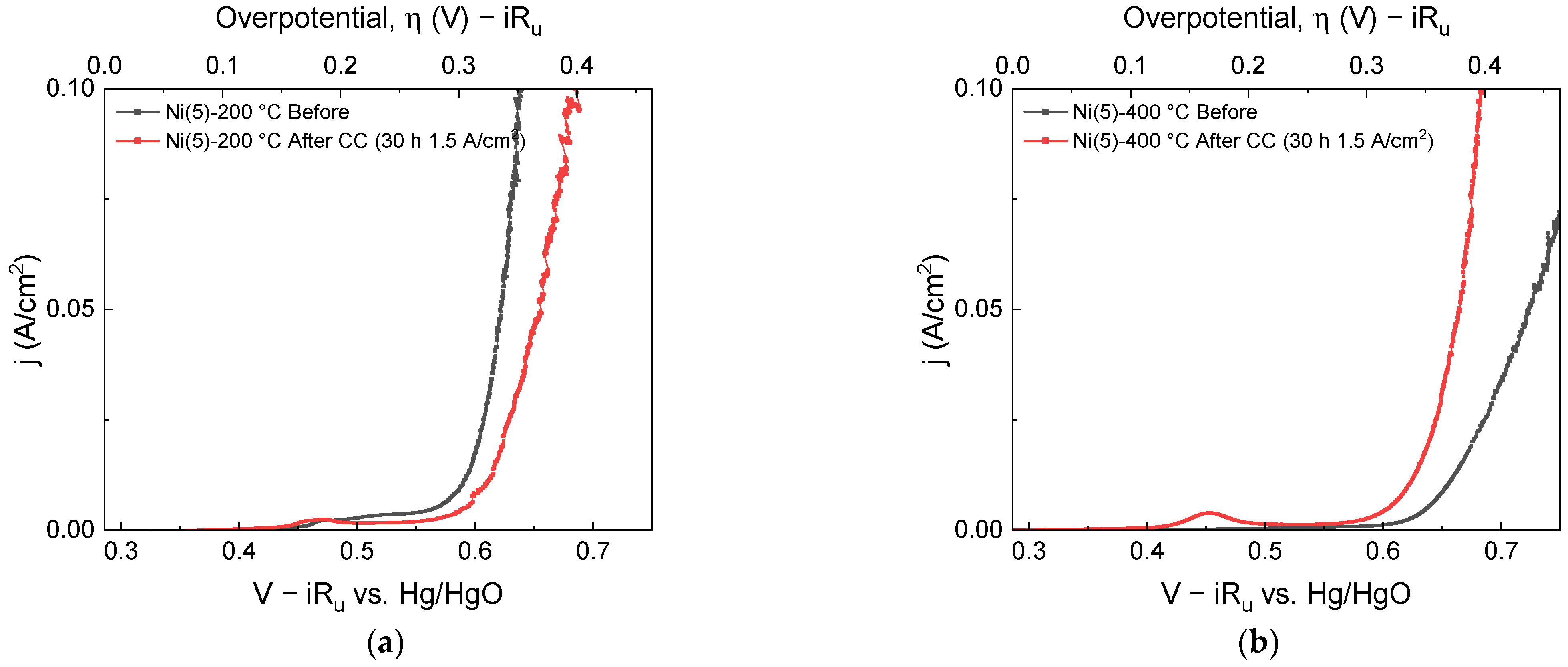

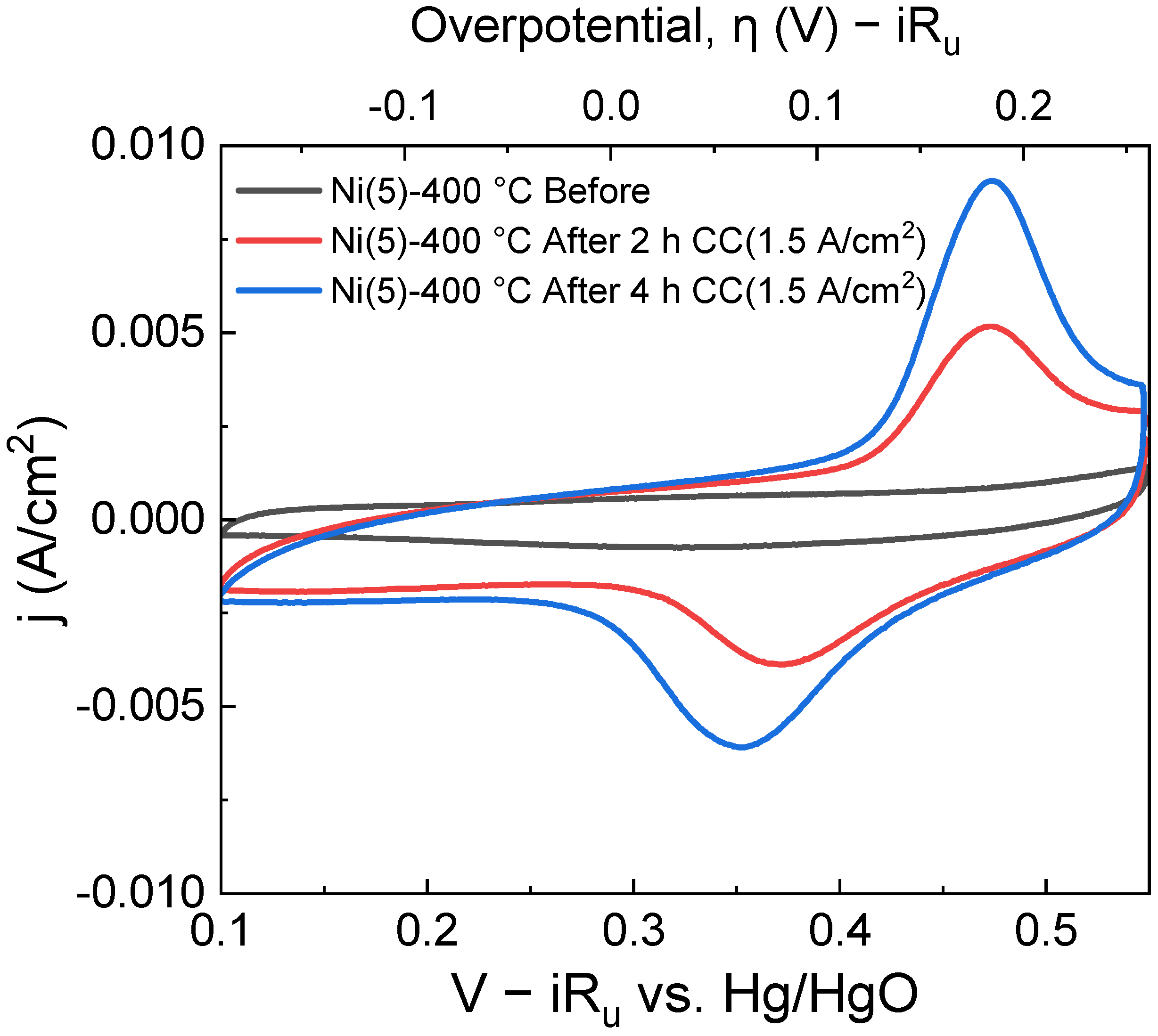

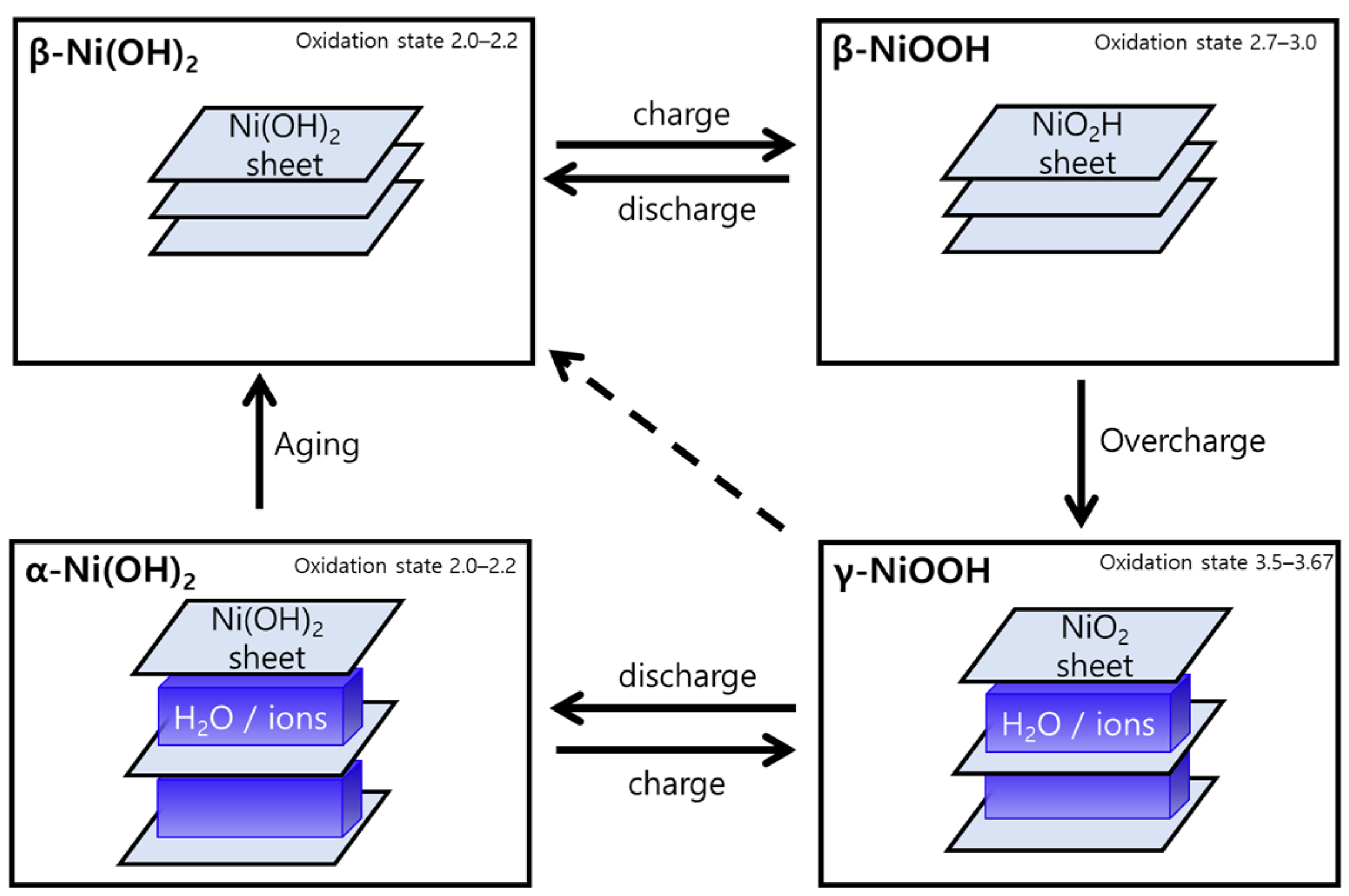
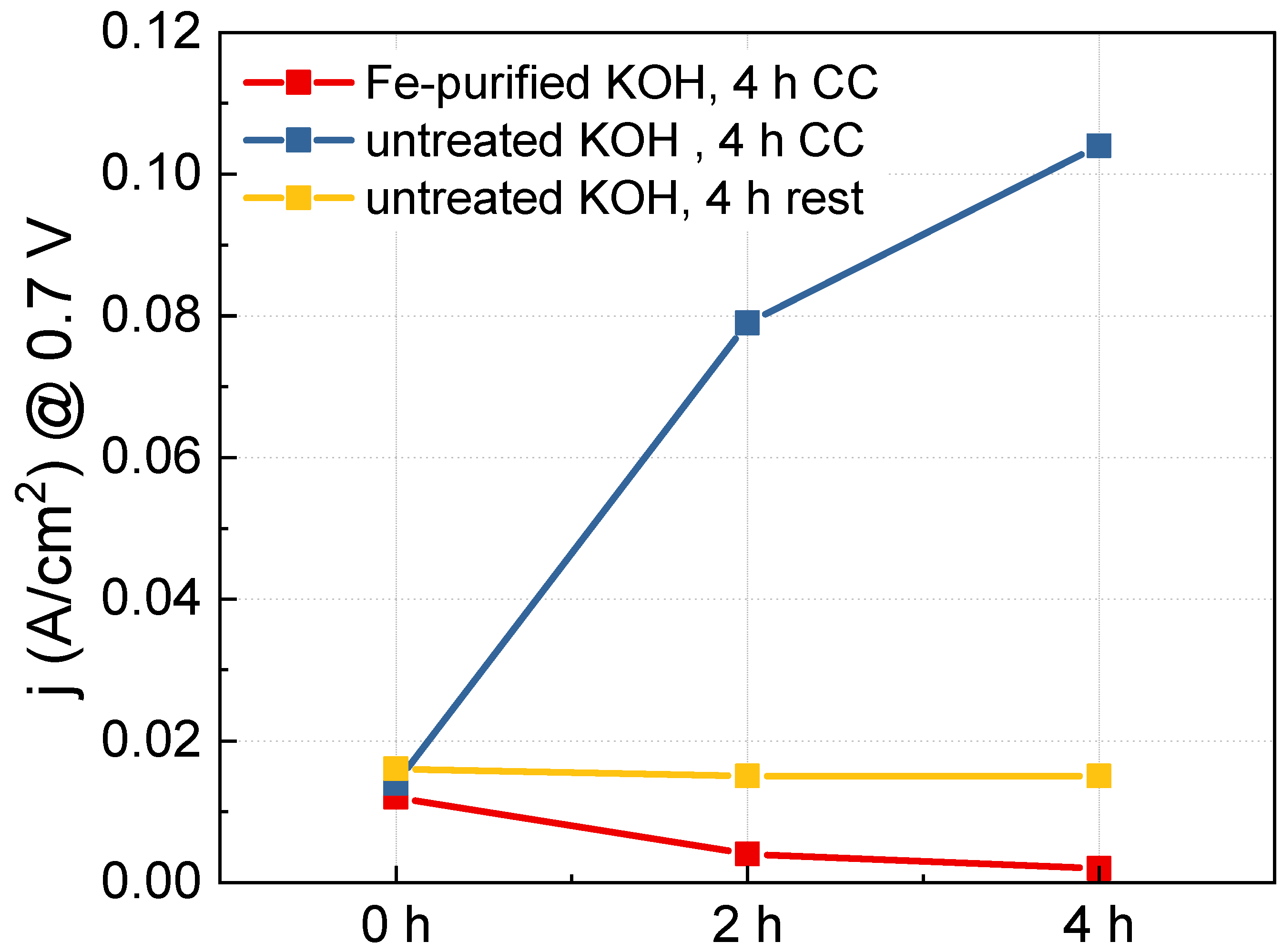
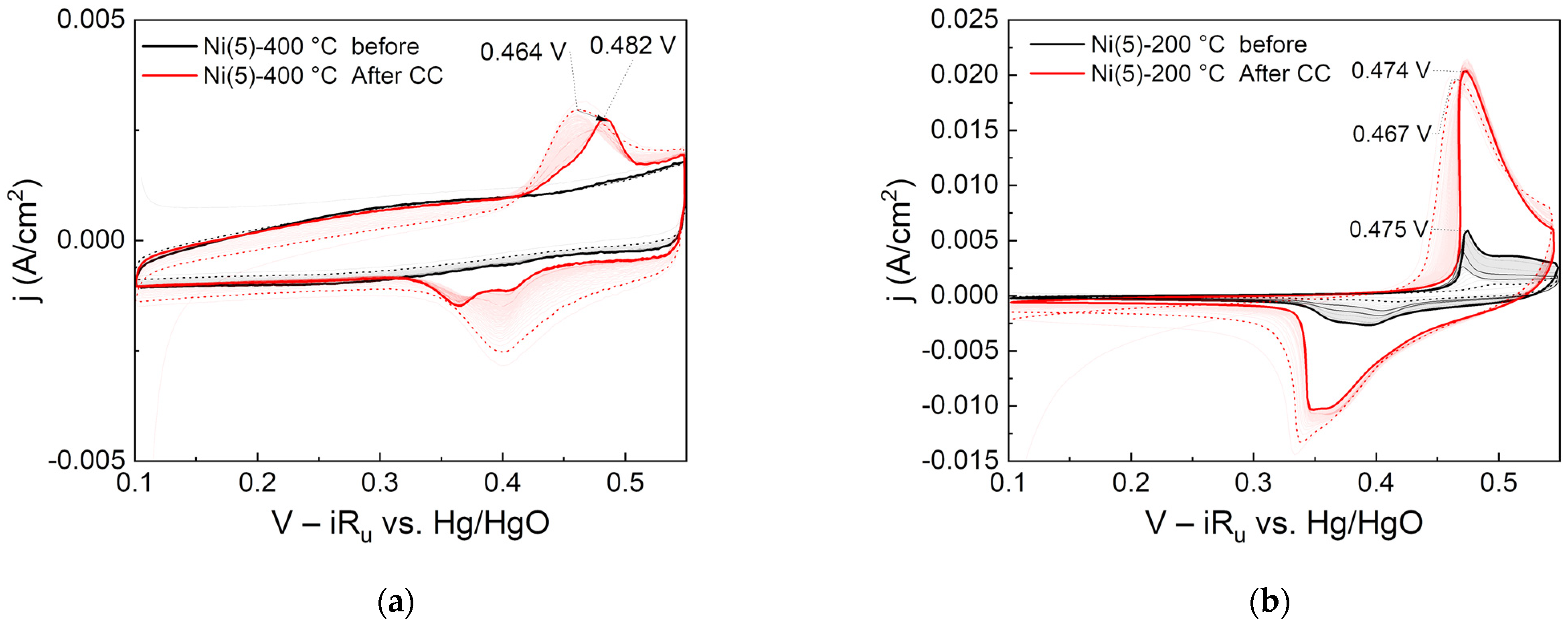
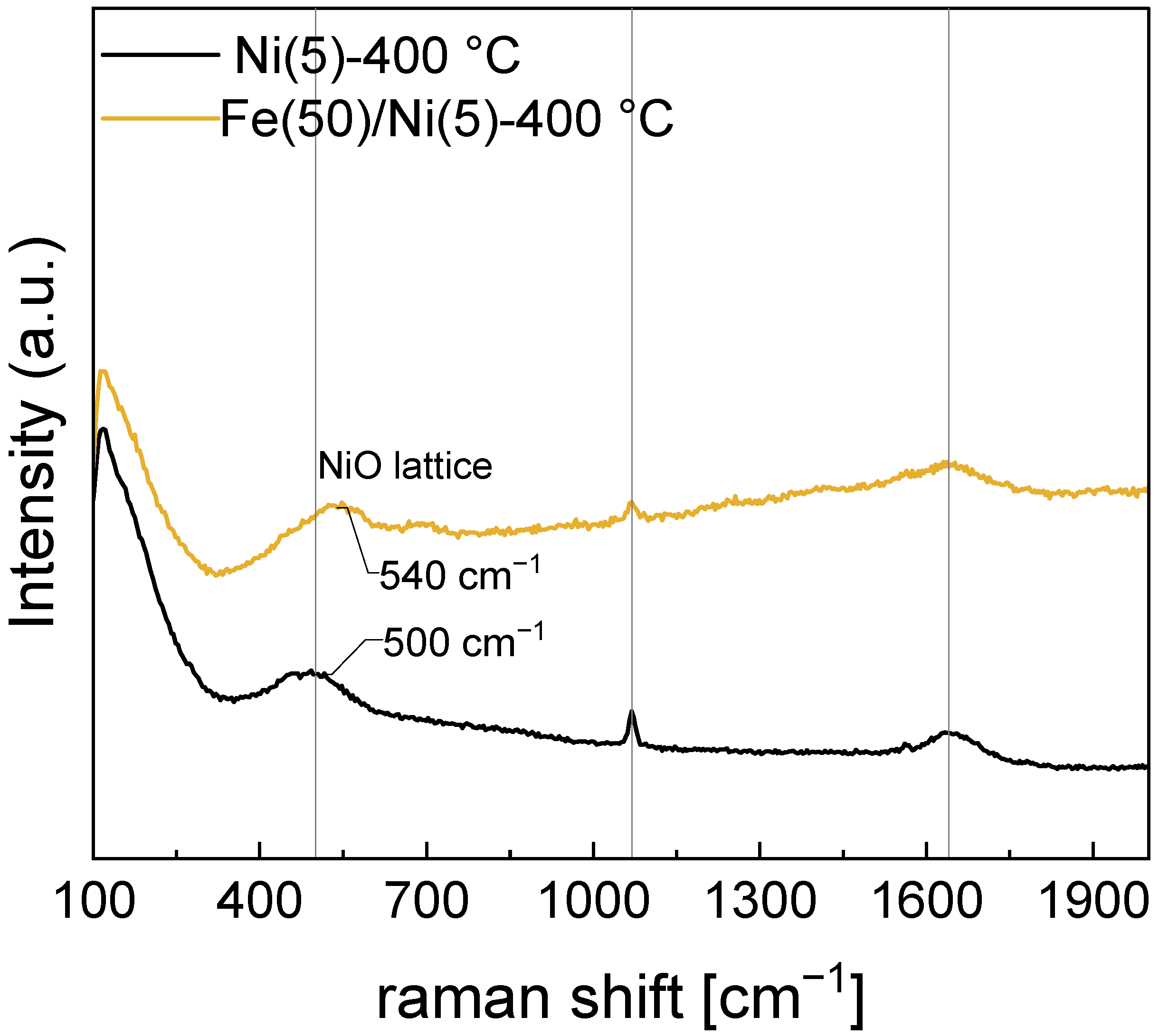


| Electrode | Ni Coating Solution | Calcined Temperature | ||
|---|---|---|---|---|
| Deionized Water | NH3 Solution | Ni Contents | ||
| Ni(5)-as | 20 mL | 80 mL | 5 mmol | - |
| Ni(5)-200 °C | 20 mL | 80 mL | 5 mmol | 200 °C |
| Ni(5)-400 °C | 20 mL | 80 mL | 5 mmol | 400 °C |
| Electrolyte | Fe Concentration (mg/L Solution) |
|---|---|
| Untreated 1 M KOH | 0.04 |
| Fe-purified 1 M KOH | <0.01 |
| Electrode | Ni Coating Solution | Fe Impregnation Solution | Calcined Temperature | |||
|---|---|---|---|---|---|---|
| Deionized Water | NH3 Solution | Ni Contents | Deionized Water | Fe Contents | ||
| Fe(50)/Ni(1)-400 °C | 20 mL | 80 mL | 1 mmol | 20 mL | 50 mmol | 400 °C |
| Fe(50)/Ni(2)-400 °C | 20 mL | 80 mL | 2 mmol | 20 mL | 50 mmol | 400 °C |
| Fe(50)/Ni(5)-400 °C | 20 mL | 80 mL | 5 mmol | 20 mL | 50 mmol | 400 °C |
| Fe(50)/Ni(10)-400 °C | 20 mL | 80 mL | 10 mmol | 20 mL | 50 mmol | 400 °C |
| Fe(50)/Ni(15)-400 °C | 20 mL | 80 mL | 15 mmol | 20 mL | 50 mmol | 400 °C |
| Electrode | Ni Coating Solution | Fe Impregnation Solution | Calcined Temperature | |||
|---|---|---|---|---|---|---|
| Deionized Water | NH3 Solution | Ni Contents | Deionized Water | Fe Contents | ||
| Fe(1)/Ni(5)-400 °C | 20 mL | 80 mL | 5 mmol | 20 mL | 1 mmol | 400 °C |
| Fe(10)/Ni(5)-400 °C | 20 mL | 80 mL | 5 mmol | 20 mL | 10 mmol | 400 °C |
| Fe(20)/Ni(5)-400 °C | 20 mL | 80 mL | 5 mmol | 20 mL | 20 mmol | 400 °C |
| Fe(50)/Ni(5)-400 °C | 20 mL | 80 mL | 5 mmol | 20 mL | 50 mmol | 400 °C |
| Fe(60)/Ni(5)-400 °C | 20 mL | 80 mL | 5 mmol | 20 mL | 60 mmol | 400 °C |
| Fe(70)/Ni(5)-400 °C | 20 mL | 80 mL | 5 mmol | 20 mL | 70 mmol | 400 °C |
| Fe(120)/Ni(5)-400 °C | 20 mL | 80 mL | 5 mmol | 20 mL | 120 mmol | 400 °C |
Disclaimer/Publisher’s Note: The statements, opinions and data contained in all publications are solely those of the individual author(s) and contributor(s) and not of MDPI and/or the editor(s). MDPI and/or the editor(s) disclaim responsibility for any injury to people or property resulting from any ideas, methods, instructions or products referred to in the content. |
© 2023 by the authors. Licensee MDPI, Basel, Switzerland. This article is an open access article distributed under the terms and conditions of the Creative Commons Attribution (CC BY) license (https://creativecommons.org/licenses/by/4.0/).
Share and Cite
Kim, T.-H.; Koo, K.-Y.; Park, C.-S.; Jeong, S.-U.; Kim, J.-E.; Lee, S.-H.; Kim, Y.-H.; Kang, K.-S. Effect of Fe on Calcined Ni(OH)2 Anode in Alkaline Water Electrolysis. Catalysts 2023, 13, 496. https://doi.org/10.3390/catal13030496
Kim T-H, Koo K-Y, Park C-S, Jeong S-U, Kim J-E, Lee S-H, Kim Y-H, Kang K-S. Effect of Fe on Calcined Ni(OH)2 Anode in Alkaline Water Electrolysis. Catalysts. 2023; 13(3):496. https://doi.org/10.3390/catal13030496
Chicago/Turabian StyleKim, Tae-Hyun, Kee-Young Koo, Chu-Sik Park, Seong-Uk Jeong, Ji-Eun Kim, Su-Han Lee, Young-Ho Kim, and Kyoung-Soo Kang. 2023. "Effect of Fe on Calcined Ni(OH)2 Anode in Alkaline Water Electrolysis" Catalysts 13, no. 3: 496. https://doi.org/10.3390/catal13030496
APA StyleKim, T.-H., Koo, K.-Y., Park, C.-S., Jeong, S.-U., Kim, J.-E., Lee, S.-H., Kim, Y.-H., & Kang, K.-S. (2023). Effect of Fe on Calcined Ni(OH)2 Anode in Alkaline Water Electrolysis. Catalysts, 13(3), 496. https://doi.org/10.3390/catal13030496








